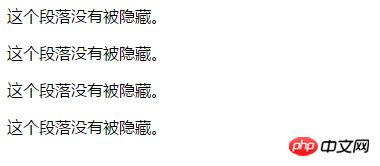
This article mainly introduces the usage of the new hidden attribute in HTML5, the usage of the hidden attribute in the
tag, and the usage in the form tag. Now let us Read this article
1. First, let’s talk about the hidden attribute:
This is a new attribute in html5, in tag can be hidden, but the browser cannot see it. See this example:
<html> <head> <meta charset="UTF-8"> <title>php中文网</title> </head> <body> <p>这个段落没有被隐藏。</p> <p>这个段落没有被隐藏。</p> <p hidden>这个段落应该被隐藏。</p> <p>这个段落没有被隐藏。</p> <p>这个段落没有被隐藏。</p> </body> </html>
I added a hidden attribute in the middle, and the others are the same as others. Let’s see the result

There are only four lines in the picture, and the middle line has disappeared.
After knowing the basic use of this attribute, let us see what role the hidden attribute represents in the form
2. The role of the hidden attribute in the form:
Hidden fields are invisible to users on the page. The purpose of inserting hidden fields into a form is to collect or send information so that it can be used by the program that processes the form. When the viewer clicks the send button to send the form, the hidden field information is also sent to the server.
Sometimes we need to give the user information and let him submit it to confirm his identity when submitting the form, such as: sessionkey, etc. Of course, these things can also be implemented using cookies, but using hidden The domain is much simpler, and there is no need to worry about browsers not supporting it and users disabling cookies.
Sometimes there are multiple submit buttons in a form. How can the program distinguish which button the user pressed to submit? We can write a hidden field and then Add onclick="document.form.command.value="xx"" to each button. Then after we receive the data, we first check the command value to know which button the user pressed to submit.
Sometimes there are multiple forms in a web page. We know that multiple forms cannot be submitted at the same time, but sometimes the forms do interact with each other, so we can add hidden fields in the form. to connect them.
JavaScript does not support global variables, but sometimes we must use global variables. We can store the value in the hidden field first, and its value will not be lost.
Another example is, for example, pressing a button will pop up four small windows. When one of the small windows is clicked, the other three will automatically close. However, IE does not support small windows calling each other, so you can only write a hidden field in the parent window. When the small window sees that the value of the hidden field is close, it will close itself.
Example: Use hidden to add 1 to the number of the submit button, and the value will increase automatically.htm
<form action="数值自增.ashx" method="post"> <input type="hidden" name="_viewstate" value="a" /> <input type="hidden" name="_div" value="@n" /> <!-- <input name="txt" type="text" value="@value" />--> <div>@n</div> <input type="submit" value="click" /> </form>
Okay, the above is about the HTML5 hidden attribute in two places usage. If you have any questions, you can ask below
[Editor’s recommendation]
What does the HTML ul tag mean? Detailed explanation of the role of HTML ul tag
How to wrap the text in the pre tag in html? Usage examples of html pre tag
The above is the detailed content of Don't know how to use the html5 hidden attribute? Then take a look at the usage of the hidden attribute of the form. For more information, please follow other related articles on the PHP Chinese website!